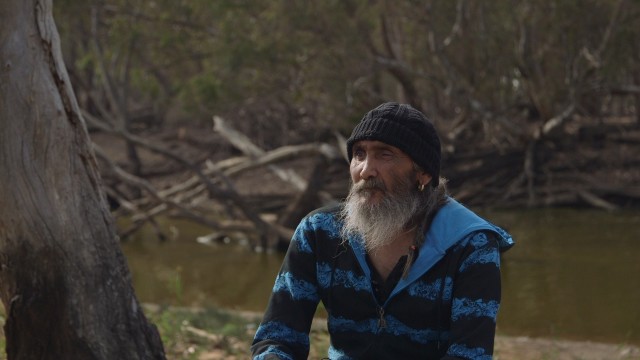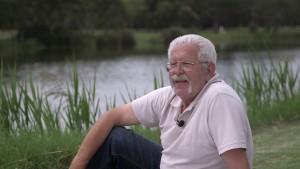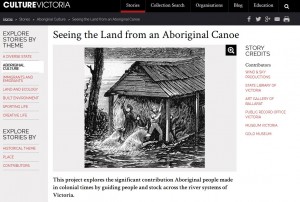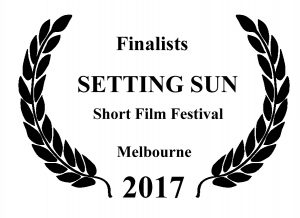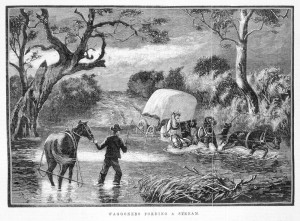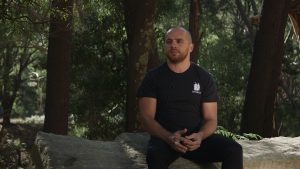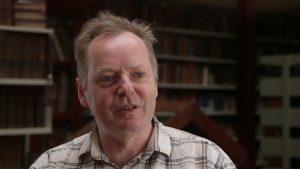Acts of Heroism
Info
Produced: 2022
Length: 15.34 minutes
Funded by: Telematics Trust
In collaboration with: Federation University
Links
Aboriginal Heroes of Flood Fire and Food Digital Map.
Uncle David Wandin, photograph by Wind & Sky Productions.
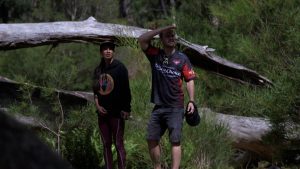
Jidah Clark and Yaraan Couzens-Bundle, photograph by Wind & Sky Productions.

Dr Fred Cahir, photograph by Wind & Sky Productions.

The Loddon River, Dja Dja Wurrung Country. Photograph by Wind & Sky Productions.
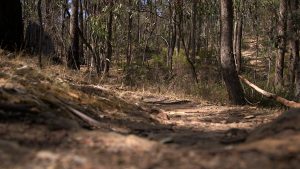
Central Victorian bushland, Djab Wurrung Country. Photograph by Wind & Sky Productions.
The Story
This short documentary film explores the history of emergency rescues and assistance in Victoria by Aboriginal people of non-Aboriginal people.
In the 19th and early 20th century Aboriginal Victorians saved lives. They knew how to manage fire and flood in the bush and where to find food in times of scarcity. Despite the devastating impacts of European invasion, Aboriginal people consistently offered help and rescue to colonists.
‘Acts of Heroism’ looks at instances where Aboriginal people took action in emergency situations in Victoria and reflects on the legacy of these shared histories. It includes Indigenous and academic perspectives, with speakers Yaraan Couzens-Bundle, Jidah Clark, Uncle David Wandin, Associate Professor Michael-Shawn Fletcher, Professor Richard Broome and Associate Professor Fred Cahir. Directed by Jary Nemo, produced and written by Lucinda Horrocks and Jary Nemo, the film features the original music of composer Deb Lowah Clark.
Warning
Viewers are advised that the film may contain images and names of people who have died.
The film mentions acts of violence and the killing times which may be distressing.
Viewers are also advised they will hear and see words written more than a hundred years ago.
In quoting the words as they were first written the film makers intend no disrespect to peoples past or present.
Background
This short film is a companion to a web-based education portal ‘Aboriginal Heroes of Fire, Food and Flood’ which spatially maps locations and documented instances of Aboriginal heroism to do with fire, flood and food in Victoria and Southeastern Australia from the 1800s to the 1930s.
The project was funded by the Telematics Trust and is a collaboration between Federation University historians, the Centre for eResearch and Digital Innovation at Federation University, and Wind & Sky Productions. The film was produced in Ballarat, in regional Victoria, on Wadawurrung Country.
More information at https://www.aboriginalheroesmatter.org.au/
Viewing the film
Not yet released to the public. Coming soon.Credits
- Featuring (in order of appearance):
- Yaraan Couzens-Bundle, Jidah Clark, Fred Cahir, Richard Broome, David Wandin and Michael-Shawn Fletcher
- And the voices of:
- Bryn Cahir, Hannah Cahir, Heather Horrocks, Kylee Smith, Tobias Horrocks, William Horrocks, Thomas Brooker
- Directed by:
- Jary Nemo
- Written and produced by:
- Lucinda Horrocks and Jary Nemo
- Executive producer:
- Fred Cahir
- Original music:
- Deb Lowah Clark
- Soundscape:
- ‘Place-we-be’. Composed, recorded and performed by Deb Lowah Clark. Featuring Deb Lowah Clark, Sarah Jane Hall, Bonnie Chew and Tony Lovett. Production support Dave Clark.
- Stock content:
- Footage courtesy of iStock by Getty Images. ‘Old Prophecy’ by Felipe Adorno Vassao. Courtesy Beat Suite.
- Equipment support:
- Assisted by a City of Ballarat Creative Inspiration Grant through Creative Ballarat and Regional Arts Victoria.
- With thanks to:
- Maxine Briggs, Craig Briody, Deb Lowah Clark, Dave Clark, Kirsten Clark, Pete Dahlhaus, Sam Henson, Kathy Horvat, Clare Gervasoni, Geoffrey Lord, Malcolm Sanders, Helen Thompson, Rob Milne, Dan Tout, Anthony Romano, Charley Woolmore, City of Ballarat, Latrobe University, Melbourne University Indigenous Knowledge Institute, Federation University Centre for eResearch and Digital Innovation (CeRDI), Regional Arts Victoria, Federation University SMB Library, Royal Historical Society Victoria, State Library Victoria and Wandoon Estate Aboriginal Corporation.
- License:
- This film has been released under a Creative Commons BY-NC-ND 4.0 International license.
- Produced in collaboration with:
- Federation University Australia
- Supported by:
- the Telematics Trust
- Companion website:
- Aboriginal Heroes Matter
- Acknowledgements:
- Film production and development took place on the lands of the Bunurong, Dja Dja Wurrung, Djab Wurrung, Jardwardjali, Taungurung, Wadawurrung, and Wurundjeri peoples. We acknowledge these Traditional Owners and pay our respects to their Elders past, present and future.
- Copyright with:
- Wind & Sky Productions ©2022 unless otherwise acknowledged.
Seeing the Land from an Aboriginal Canoe at Setting Sun Short Film Festival

We are delighted to announce that Seeing the Land from an Aboriginal Canoe is a Finalist for two awards, Best Cultural Diversity and Best Documentary Metro at the Setting Sun Short Film Festival. The film will be screening at the Sun Theatre, Yarraville on Friday the 28th of April as part of the 7pm session
Where: 8 Ballarat Street, Yarraville 3013 Victoria, Australia � Tel 03 9362 0999 Fax 03 9362 0337 info@suntheatre.com.au
When: 7 pm – 10 pm Friday 28 April 2017
Tickets: This is a ticketed event Tickets at https://www.suntheatre.com.au/component/yco/?view=movie&movie=SSETTINGSUN%3ABRID
Highly Commended in MAGNA Awards 2016
We are delighted to announce that ‘Seeing the Land from an Aboriginal Canoe’ was Highly Commended in its category at the Museums and Galleries National Awards, the MAGNA 2016 Awards, announced on the 18th May 2016 in Auckland.
Read More Wind & Sky Productions
Wind & Sky Productions




